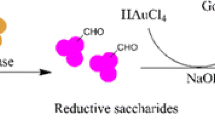Synopsis
This paper describes a general method for the determination of the molar extinction ceefficient of a chromophore covalently bound to structure-linked groups, without isolating the compound formed. The method is illustrated by the determination of the molar extinction coefficient of the reaction product of 2,4-dinitro-1-fluorobenzene (DNFB) with films of aminoethyl-cellulose (AE-cellulose). The method is based on the relation between the decrease in extinction of a DNFB staining solution and the increase in extinction of the AE-cellulose after staining as measured in a film-spectrophotometer. In addition, the value of the molar extinction coefficient was used in establishing reaction conditions for a quantitative staining procedure for determining amino groups with DNFB and picric acid. Conditions of optimum DNFB staining were determined and the measured extinction was converted into concentration of amino groups using the molar extinction coefficient. The amino group concentration of the same batch of AE-cellulose was also determined, after finding the optimum reaction conditions, by staining with picric acid. The results, when compared, showed a linear relationship with a slope of unity for batches of AE-cellulose of varying amino group concentrations. This is consistent with the same stoichiometry in both cases and indicates that in both procedures one chromophore molecule has reacted with one amino group and that this reaction has proceeded to completion. The general applicability of the method is discussed.
Similar content being viewed by others
References
Ahsmann, W. B. A. M. &van Duijn, P. (1968). Aminoacid cellulose films as models for histochemical protein reactions.Histochemie 12, 285–8.
Dubin, D. T. (1960). The essay and characterization of amino by means of 2,4-dinitrofluoro benzene.J. biol. Chem. 235, 783–6.
Duijn, P. Van, Den tonkellaar, E. M. &Hardonk, M. J. (1962). An improved apparatus for quantitative cytochemical model studies and its use in an experimental test of the two-wavelength method.J. Histochem. Cytochem. 10, 473–80.
Fisher, E. R. &Lillie, R. D. (1954). The effect of methylation on basophilia.J. Histochem. Cytochem. 2, 81–7.
Geiger, E. &Wissler, A. (1945). Beitrage zur Kenntnis von Oxy- und Hydrocellulose.Helv. chim. Acta 28, 1638–47.
Hardonk, M. J. &van Duijn, P. (1964). Synthesis and properties of model systems, with their use in studying the Schiff Reaction in Histochemistry.J. Histochem. Cytochem. 12, 533–7.
Maddy, A. H. (1961). 1-fluoro-2,4-dinitrobenzene as a cytochemical reagent. InGeneral Cytochemical Methods (ed. J. F. Danielli), Vol. 2, 259–85. New York: Academic Press.
Mitchell, J. P. (1967). Combined protein and DNA measurements in plant cells using the dinitrofluorobenzene and Feulgen techniques.Jl R. microsc. Soc. 87, 1–7.
Persijn, J. P. &Van Duijn, P. (1961). Studies of the Feulgen Reaction with the aid of DNA incorporated cellulose films.Histochemie 2, 283–97.
Ploeg, M. Van Der &Van Duijn, P. (1968). Cytophotometric determination of alkaline phosphatase activity of individual neutrophilic leucocytes with a biochemically calibrated model system.J. Histochem. Cytochem. 16, 693–706.
Samuelson, O. (1963). Determination of carboxyl groups. InMethods in Carbohydrate Chemistry (ed. R. L. Whistler), Vol. 3, pp. 31–8, New York: Academic Press.
Sanger, F. (1945). The few amino groups of insuline.Biochem. J. 39, 507–15.
Walker, P. M. B. (1958). Ultraviolet microspectrophotometry. InGeneral Cytochemical Methods (ed. J. F. Danielli), Vol. I, pp. 163–217. New York: Academic Press.
Zerlotti, F. &Engel, M. B. (1962). The reactivity of proteins of some connective tissues and epithelial structures with 2,4-dinitrofluorobenzene.J. Histochem. Cytochem. 10, 527–46.
Author information
Authors and Affiliations
Rights and permissions
About this article
Cite this article
Van Dalen, J.P.R., Ahsmann, W.B.A.M. & Van Duijn, P. A method for the determination of the molar extinction coefficient of structure-linked chromophores. Histochem J 2, 329–342 (1970). https://doi.org/10.1007/BF01005001
Received:
Issue Date:
DOI: https://doi.org/10.1007/BF01005001




